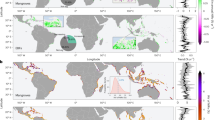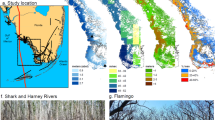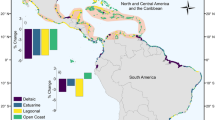Abstract
Mangrove wetlands are among the most productive and carbon-dense ecosystems in the world. Their structural attributes vary considerably across spatial scales, yielding large uncertainties in regional and global estimates of carbon stocks. Here, we present a global analysis of mangrove canopy height gradients and aboveground carbon stocks based on remotely sensed measurements and field data. Our study highlights that precipitation, temperature and cyclone frequency explain 74% of the global trends in maximum canopy height, with other geophysical factors influencing the observed variability at local and regional scales. We find the tallest mangrove forests in Gabon, equatorial Africa, where stands attain 62.8 m. The total global mangrove carbon stock (above- and belowground biomass, and soil) is estimated at 5.03 Pg, with a quarter of this value stored in Indonesia. Our analysis implies sensitivity of mangrove structure to climate change, and offers a baseline to monitor national and regional trends in mangrove carbon stocks.
This is a preview of subscription content, access via your institution
Access options
Access Nature and 54 other Nature Portfolio journals
Get Nature+, our best-value online-access subscription
$29.99 / 30 days
cancel any time
Subscribe to this journal
Receive 12 print issues and online access
$259.00 per year
only $21.58 per issue
Buy this article
- Purchase on Springer Link
- Instant access to full article PDF
Prices may be subject to local taxes which are calculated during checkout




Similar content being viewed by others
Data availability
The data that support the findings of this study are available from the Oak Ridge National Data Archive (ORNL DAAC; https://doi.org/10.3334/ORNLDAAC/1665) as GEOTIFF files and as an online webmapping tool (https://mangrovescience.earthengine.app/view/mangroveheightandbiomass). The in situ field data that have not been published previously are also available through the ORNL DAAC as .csv files listing individual tree measurements (https://doi.org/10.3334/ORNLDAAC/1665). The SRTM and ICESat/GLAS data sets used as input to generate the maps can be downloaded from https://lta.cr.usgs.gov/SRTM and https://nsidc.org/data/icesat/data.html, respectively. The global mangrove map26 is freely available at http://data.unep-wcmc.org/datasets/4. The tropical cyclone and SSS data are available from NOAA archives https://data.nodc.noaa.gov/cgi-bin/iso?id=gov.noaa.ncdc:C00834 (https://doi.org/10.7289/V5NK3BZP) and https://podaac.jpl.nasa.gov/dataset/AQUARIUS_L3_SSS_CAP_MONTHLY_V4?ids=Platform&values=AQUARIUS_SAC-D (https://doi.org/10.5067/AQR40-3TMCS). The WorldClim data are available at http://worldclim.org/version2.
References
McLeod, E. et al. A blueprint for blue carbon: toward an improved understanding of the role of vegetated coastal habitats in sequestering CO2. Front. Ecol. Environ. 9, 552–560 (2011).
Donato, D. C. et al. Mangroves among the most carbon-rich forests in the tropics. Nat. Geosci. 4, 293–297 (2011).
Alongi, D. M. Carbon cycling and storage in mangrove forests. Annu. Rev. Mar. Sci 6, 195–219 (2014).
Bouillon, S. et al. Mangrove production and carbon sinks: a revision of global budget estimates. Global. Biogeochem. Cycles 22, GB2013 (2008).
Barbier, E. B. et al. The value of estuarine and coastal ecosystem services. Ecol. Monogr. 81, 169–193 (2011).
Polidoro, B. A. et al. The loss of species: mangrove extinction risk and geographic areas of global concern. PLoS ONE 5, e10095 (2010).
Murdiyarso, D. et al. The potential of Indonesian mangrove forests for global climate change mitigation. Nat. Clim. Change 5, 8–11 (2015).
Richards, D. R. & Friess, D. A. Rates and drivers of mangrove deforestation in Southeast Asia, 2000–2012. Proc. Natl Acad. Sci. USA 113, 344–349 (2016).
Krauss, K. W. et al. How mangrove forests adjust to rising sea level. New Phytol. 202, 19–34 (2014).
Lovelock, C. et al. The vulnerability of Indo-Pacific mangrove forests to sea-level rise. Nature 526, 559–563 (2015).
Sasmito, S. D., Murdiyarso, D., Friess, D. & Kurniato, S. Can mangroves keep pace with contemporary sea level rise? A global data review. Wetlands Ecol. Manage. 24, 263–278 (2016).
Hamilton, S. E. & Casey, D. Creation of a high spatio-temporal resolution global database of continuous mangrove forest cover for the 21st century (CGMFC-21). Glob. Ecol. Biogeogr. 25, 729–738 (2016).
Lovelock, C. E., Reuss, R. W. & Feller, I. C. CO2 efflux from cleared mangrove peat. PLoS ONE 6, e21279 (2011).
Kauffman, J. B., Heider, C., Norfolk, J. & Payton, F. Carbon stocks of intact mangroves and carbon emissions arising from their conversion in the Dominican Republic. Ecol. Appl. 24, 518–527 (2014).
Hamilton, S. E. & Friess, D. A. Global carbon stocks and potential emissions due to mangrove deforestation from 2000 to 2012. Nat. Clim. Change 8, 240–244 (2018).
Hutchison, J., Manica, A., Swetnam, R., Balmford, A. & Spalding, M. Predicting global patterns in mangrove forest biomass. Conserv. Lett. 7, 233–240 (2014).
Rovai, A. S. et al. Scaling mangrove aboveground biomass from site-level to continental-scale. Glob. Ecol. Biogeogr. 25, 286–298 (2016).
Saenger, P. & Snedaker, S. C. Pantropical trends in mangrove above-ground biomass and annual litterfall. Oecologia 96, 293–299 (1993).
Twilley, R. R. & Rivera-Monroy, V. H. in Coastal Wetlands: An Integrated Ecosystem Approach (eds Perillo, G. M. E. et al.) Ch. 23 (Elsevier, Amsterdam, 2009).
Thom, B. G. in Mangrove Ecosystems in Australia (ed. Clough, B. F.) 3–17 (Australian National Univ. Press, Canberra, 1982).
Danielson, T. M. et al. Assessment of Everglades mangrove forest resilience: implications for above-ground net primary productivity and carbon dynamics. Forest Ecol. Manage. 404, 115–125 (2017).
Twilley, R. R. et al. in Mangrove Ecosystems: A Global Biogeographic Perspective (eds Rovera-Monroy, V. H. et al.) Ch. 5 (Springer, Basel, 2017).
Simard, M., Rivera-Monroy, V. H., Mancera-Pineda, J. E., Castañeda-Moya, E. & Twilley, R. R. A systematic method for 3D mapping of mangrove forests based on Shuttle Radar Topography Mission elevation data, ICEsat/GLAS waveforms and field data: application to Ciénaga Grande de Santa Marta, Colombia. Remote Sens. Environ. 112, 2131–2144 (2008).
Castañeda-Moya, E., Twilley, R. R. & Rivera-Monroy, V. H. Allocation of biomass and net primary productivity of mangrove forests along environmental gradients in the Florida coastal Everglades, USA. Forest Ecol. Manage. 307, 226–241 (2013).
Balke, T. & Friess, D. A. Geomorphic knowledge for mangrove restoration: a pan-tropical categorization. Earth Surf. Process. Landforms 41, 231–239 (2016).
Giri, C. et al. Status and distribution of mangrove forests of the world using earth observation satellite data. Glob. Ecol. Biogeogr. 20, 154–159 (2011).
Simard, M., Pinto, N., Fisher, J. B. & Baccini, A. Mapping forest canopy height globally with spaceborne lidar. J. Geophys. Res. Biogeosci. 116, G04021 (2011).
Pan, Y., Birdsey, R. A., Phillips, O. L. & Jackson, R. B. The structure, distribution, and biomass of the world’s forests. Annu. Rev. Ecol. Evol. Syst. 44, 593–622 (2013).
Hijmans, R. J., Cameron, S. E., Parra, J. L., Jones, P. G. & Jarvis, A. Very high resolution interpolated climate surfaces for global land areas. Int. J. Climatol. 25, 1965–1978 (2005).
Ward, R. D., Friess, D. A., Day, R. H. & MacKenzie, R. A. Impacts of climate change on mangrove ecosystems: a region by region overview. Ecosyst. Health Sustain. 2, e01211 (2016).
Farfán, L. M., D’Sa, E. J., Liu, K.-b & Rivera-Monroy, V. H. Tropical cyclone impacts on coastal regions: the case of the Yucatán and the Baja California Peninsulas, Mexico. Estuar. Coasts 37, 1388–1402 (2014).
Osland, M. J. et al. Climatic controls on the global distribution, abundance, and species richness of mangrove forests. Ecol. Monogr. 87, 341–359 (2017).
Terray, L. et al. Near-surface salinity as nature’s rain gauge to detect human influence on the tropical water cycle. J. Clim. 25, 958–977 (2012).
Twilley, R. R. in Maximum Power: the Ideas and Applications of H.T. Odum (ed. Hall, C. A. S.) 43–62 (Univ. Press Colorado, Niwot, 1995).
Kauffman, J. B. & Bhomia, R. K. Ecosystem carbon stocks of mangroves across broad environmental gradients in West-Central Africa: global and regional comparisons. PLoS ONE 12, e0187749 (2017).
Rovai, A. S. et al. Global controls on carbon storage in mangrove soils. Nat. Clim. Change 8, 534–538 (2018).
Sanderman, J. et al. A global map of mangrove forest soil carbon at 30 m spatial resolution. Environ. Res. Lett. 13, 055002 (2018).
Bouillon, S. Carbon cycle: storage beneath mangroves. Nat. Geosci. 4, 282–283 (2011).
Lovelock, C. E. et al. Assessing the risk of carbon dioxide emissions from blue carbon ecosystems. Front. Ecol. Environ. 15, 257–265 (2017).
Fatoyinbo, T., Feliciano, E. A., Lagomasino, D., Lee, S. K. & Trettin, C. Estimating mangrove aboveground biomass from airborne LiDAR data: a case study from the Zambezi River delta. Environ. Res. Lett. 13, 025012 (2017).
Atwood, T. B. et al. Global patterns in mangrove soil carbon stocks and losses. Nat. Clim. Change 7, 523–528 (2017).
Chave, J. et al. Tree allometry and improved estimation of carbon stocks and balance in tropical forests. Oecologia 145, 87–99 (2005).
Siikamäki, J., Sanchirico, J. N. & Jardine, S. L. Global economic potential for reducing carbon dioxide emissions from mangrove loss. Proc. Natl Acad. Sci. USA 109, 14369–14374 (2012).
Twilley, R. R., Chen, R. H. & Hargis, T. Carbon sinks in mangroves and their implications to carbon budget of tropical coastal ecosystems. Water Air Soil Pollut. 64, 265–288 (1992).
Feka, N. Z. & Ajonina, G. N. Drivers causing decline of mangrove in West-Central Africa: a review. Int. J. Biodiv. Sci. Ecosys. Serv. Manage. 7, 217–230 (2011).
Omo-Irabor, O. O. et al. Mangrove vulnerability modelling in parts of Western Niger Delta, Nigeria using satellite images, GIS techniques and Spatial Multi-Criteria Analysis (SMCA). Environ. Monit. Assess. 178, 39–51 (2011).
Hinson, A. L. et al. The spatial distribution of soil organic carbon in tidal wetland soils of the continental United States. Glob. Chang. Biol. 23, 5468–5480 (2017).
Farr, T. et al. The Shuttle Radar Topography Mission. Rev. Geophys. 45, RG2004 (2007).
Simard, M. et al. Mapping height and biomass of mangrove forests in Everglades National Park with SRTM elevation data. Photogramm. Eng. Remote Sens. 72, 299–311 (2006).
Fatoyinbo, T. E., Simard, M., Washington-Allen, R. A. & Shugart, H. H. Landscape-scale extent, height, biomass, and carbon estimation of Mozambique's mangrove, forests with Landsat ETM+ and Shuttle Radar Topography Mission elevation data. J. Geophys. Res. Biogeosci. 113, G02S06 (2008).
Fatoyinbo, T. E. & Simard, M. Height and biomass of mangroves in Africa from ICESat/GLAS and SRTM. Int. J. Remote Sens. 34, 668–681 (2013).
Lagomasino, D., Fatoyinbo, T., Lee, S. & Feliciano, E. A. Comparison of mangrove canopy height using multiple independent measurements from land, air, and space. Remote Sens. 8, 327 (2016).
Hansen, M. C. et al. High-resolution global maps of 21st-century forest cover change. Science 342, 850–853 (2013).
Rodríguez, E., Morris, C. S. & Belz, E. A global assessment of the SRTM performance. Photogramm. Eng. Remote Sens. 72, 249–260 (2006).
Stringer, C. E. et al. The Zambezi River Delta Mangrove Carbon Project: A Pilot Baseline Assessment for REDD+ Reporting and Monitoring. Final Report 1–56 (United States Forest Service, 2014).
Trettin, C. C., Stringer, C. E. & Zarnoch, S. J. Composition, biomass and structure of mangroves within the Zambezi River Delta. Wetl. Ecol. Manag. 24, 173–186 (2015).
Fick, S. E. & Hijmans, R. J. WorldClim 2: new 1-km spatial resolution climate surfaces for global land areas. Int. J. Climatol. 37, 4302–4315 (2017).
Wang, X., Chao, Y., Shum, C. K., Yi, Y. & Fok, H. S. Comparison of two methods to assess ocean tide models. J. Atmos. Ocean. Technol. 29, 1159–1167 (2012).
Yueh, S. H., Tang, W., Hayashi, A. K. & Lagerloef, G. S. E. L-band passive and active microwave geophysical model functions of ocean surface winds and applications to Aquarius retrieval. IEEE Trans. Geosci. Remote Sens. 51, 4619–4632 (2014).
Seabold, S. & Perktold, J. Statsmodels: econometric and statistical modeling with Python. Proc. 9th Python Sci. Conf. 57–61 (2010).
QGIS Development Team. QGIS Geographic Information System. Open Source Geospatial Foundation Project (2018); https://www.osgeo.org/projects/qgis/
Bunting, P., Clewley, D., Lucas, R. M. & Gillingham, S. The Remote Sensing and GIS Software Library (RSGISLib). Comput. Geosci. 62, 216–226 (2014).
Tange, O. GNU Parallel 2018 (2018); https://doi.org/10.5281/zenodo.1146014
Aslan, A., Rahman, A. F., Warren, M. W. & Robeson, S. M. Mapping spatial distribution and biomass of coastal wetland vegetation in Indonesian Papua by combining active and passive remotely sensed data. Remote Sens. Environ. 183, 65–81 (2016).
Chave, J. et al. Improved allometric models to estimate the aboveground biomass of tropical trees. Glob. Chang. Biol. 20, 3177–3190 (2014).
Chave, J. et al. Towards a worldwide wood economics spectrum. Ecol. Lett. 12, 351–366 (2009).
Hiraishi, T. et al. 2013 Supplement to the 2006 IPCC Guidelines for National Greenhouse Gas Inventories: Wetlands. Methodological Guidance on Lands with Wet and Drained Soils, and Constructed Wetlands for Wastewater Treatment (IPCC, 2014).
Komiyama, A., Ong, J. E. & Poungparn, S. Allometry, biomass, and productivity of mangrove forests: a review. Aquat. Bot. 89, 128–137 (2008).
Castañeda-Moya, E. et al. Patterns of root dynamics in mangrove forests along environmental gradients in the Florida coastal Everglades, USA. Ecosystems 14, 1178–1195 (2011).
Acknowledgements
This work was conducted by the Jet Propulsion Laboratory (JPL), California Institute of Technology (Caltech), under contract with the National Aeronautics and Space Administration (NASA). This work was funded by the NASA Land-Cover/Land-Use Change (LCLUC) Program project ‘Vulnerability Assessment of Mangrove Forest Regions of the Americas’, the NASA Carbon Monitoring System (CMS) project ‘Total Carbon Estimation in African Blue Carbon Ecosystems’ (14-CMS14-0028), the Florida Coastal Everglades Long-Term Ecological Research program (FCE-LTER; grants nos. DBI-0620409 and DEB-1237517) and the Department of Interior, South-Central Climate Science Center. We furthermore acknowledge funding by the United States Agency for International Development SilvaCarbon Program, the United States Department of Agriculture – Forest Service International Programs and the Center for International Forestry Research (CIFOR) Sustainable Wetlands Adaptation Mitigation (SWAMP) Program for field data collection in Mozambique and Bangladesh. The authors thank M. Rahman (Kyoto University, Japan), Z. Iqbal (SilvaCarbon Bangladesh and Bangladesh Forest Service), I. Ahmed (Bangladesh Forest Service) and the Bangladesh Forest Service for providing access to the Sundarbans Mangrove Carbon Assessment field data. The authors also thank the Agence Nationale des Parcs Nationaux (ANPN) and Centre National de la Recherche Scientifique et Technologique (CENAREST) in Gabon, in particular, K. Jeffery, A. Flore, K. Pambo and L. White for providing field permits and access to Pongara National Park for the validation of canopy heights. The authors thank the Ministerio del Ambiente, Energia y Telecomunicacion (MINAET) for providing the field permits for data collection in Costa Rica, and the Organization of Tropical Studies (Costa Rica), E. Medina (Instituto Venezolano de Investigaciones Cientificas, Venezuela), V.E. Mena Mosquera (Universidad Tecnológica del Chocó, Colombia), M.M. Pozo Cajas (Escuela Superior Politecnica del Litoral, Ecuador), J.E. Pineda Mancera (Universidad Nacional de Colombia, Colombia), M. Obiang (Université Omar Bongo, Gabon) and the Comisión Nacional para el Conocimiento y Uso de la Biodiversidad (CONABIO, Mexico) for in situ field support. Thanks also go to N. Pinto and M. Denbina (JPL, Caltech), R. Aguilar (Vascular Plants of the Osa Peninsula, Costa Rica), A. Armstrong (United Space Research Association/NASA GSFC, USA), P. Montesano (Sigma Space Applications International/NASA GSFC, USA), G. Sun (University of Maryland and NASA GSFC, USA), A. Vega (AMBICOR, Costa Rica), J. Corcoran (JPL, Caltech, USA), C. Trettin (USDA Forest Service, USA), L. Duncanson (University of Maryland/NASA GSFC), A. Williams (Louisiana State University, USA), H. Tavera (MarViva, Colombia), P. Walfir Souza-Filho, M. Ferreira Cougo and R. Salum (Universidade Federal do Pará, Brazil), I. Longa (Agence Gabonaise d’Etudes et Observations Spaciales, Gabon), S.K. Lee (University of Maryland/GSFC, USA) and D. Lagomasino (University of Maryland/GSFC, USA) for help in the field. The authors thank X.C. Wang (JPL, Caltech) for providing the tidal range data and S.K. Lee, R. Lucas (University of Aberystwith, Wales) and D. Lagomasino for providing edits to the manuscript. Conservation International, through the Blue Carbon initiative, supported identification of knowledge gaps and local stakeholders.
Author information
Authors and Affiliations
Contributions
M.S. and L.F. conceived and designed the study. M.S. led the SRTM and ICESat/GLAS data processing, with assistance from C.S., L.F. and N.T. Field data processing and biomass model development were led by L.F., with assistance from M.S. Field experimental design and data collection were carried out by M.S., L.F., V.R.-M., E.C.-M. and N.T. The interpretation of data and generation of results were performed by M.S., L.F., C.S., V.R.-M., E.C-M., T.V.D.S. and N.T. The writing of the paper was led by M.S. and L.F., with input from all co-authors.
Corresponding authors
Ethics declarations
Competing interests
The authors declare no competing interests.
Additional information
Publisher’s note: Springer Nature remains neutral with regard to jurisdictional claims in published maps and institutional affiliations.
Supplementary information
Supplementary Information
Supplementary Figures 1–6 and Supplementary Tables 1–9.
Rights and permissions
About this article
Cite this article
Simard, M., Fatoyinbo, L., Smetanka, C. et al. Mangrove canopy height globally related to precipitation, temperature and cyclone frequency. Nature Geosci 12, 40–45 (2019). https://doi.org/10.1038/s41561-018-0279-1
Received:
Accepted:
Published:
Issue Date:
DOI: https://doi.org/10.1038/s41561-018-0279-1
This article is cited by
-
Integrating mangrove growth and failure in coastal flood protection designs
Scientific Reports (2024)
-
Mapping and monitoring of mangrove species in Eastern Lagoon National Park, Abu Dhabi, using Landsat 8 OLI data
Arabian Journal of Geosciences (2024)
-
Mangroves of Malaysia: a comprehensive review on ecosystem functions, services, restorations, and potential threats of climate change
Hydrobiologia (2024)
-
Mangrove reforestation provides greater blue carbon benefit than afforestation for mitigating global climate change
Nature Communications (2023)
-
Priority areas to protect mangroves and maximise ecosystem services
Nature Communications (2023)



